
Click on map for a larger
overall Galapagos map
Pacific Landfalls Ecuador Pages Related Pages Ecuador NewslettersGalapagos Letters Galap Flora/Fauna |
Santa Cruz
 Click on map for a larger overall Galapagos map |
Language: Spanish
Population: About 3000 around the village of Puerto Ayora.
Immigration is supposed to be strictly controlled to lessen the environmental impact.
Money: US Dollars
Landscape: Dry, volcanic, with low hills covered in native and introduced vegetation.
Visited: April 23, 2003 to May 15, 2003
Geological Development
Ecological Development
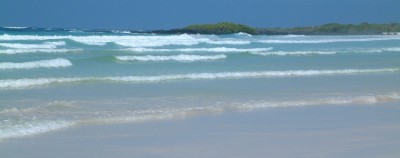 Glorious boogie-boarding waves on Tortuga Beach |
History: The Galapagos were officially claimed by Ecuador in 1832, and after that
many settlers came to inhabit these beautiful islands. It wasn't until nearly a
hundred years later, however, that Santa Cruz's first settlement was formed. In
1926, a group of Norwegians came to the Galapagos, and made their homes in
Puerto Ayora.
From 1850 to 1950, or thereabouts, Britain and the US had been trying to lease
or purchase the islands from Ecuador, but neither nations quite managed it. They
had named the islands, however, with English names. In 1950, Ecuador changed
that, giving each island a Spanish name. This is why most of the islands have
several names. Santa Cruz was named so by the Ecuadorians because it means "holy
cross," whereas the British named it Indefatigable after their very own HMS
Indefatigable.
In World War II, the Americans were allowed to build an airbase on Baltra
Island, just north of Santa Cruz. This base was used to patrol the Pacific side
of the Panama Canal, but the island was given back to Ecuador at the end of the
war. One of the airstrips is still in use, as a commercial airport, but the rest
of the base has been reduced to rubble.
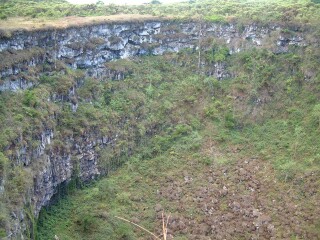 One of several giant sinkholes on Santa Cruz |
You can also read our Galapagos Cruising Information Newsletter that we emailed from the boat while we were there. And on Sue's pages, there is more on the Flora and Fauna and Birds of the Galapagos.
(Amanda age 14) Dad had been having problems with a tooth ever since our passage to the
Galapagos, and he didn't like the dental care in Wreck Bay, the capital of the
Galapagos, so we toodled off before Vamp to Puerto Ayora, a much bigger city.
And, to our surprise and delight, met up once again with Wanderer IV, friends we
had last seen in Panama. We had expected that they would be on their way to the
Marquesas, but here they were!
Maya spent no time dragging me ashore to show me the town, get an ice cream, and
then take me to Tortuga Beach, a terrific surfing beach 3 km away from town. We
spent many an afternoon there, with our boogie boards, hitting the waves.
 Chris and a Galapago at the Darwin Center |
(Chris age 16) I enjoyed Santa Cruz. The inhabited parts are very neat, and the wilderness
is beautiful. The tour of the highlands was interesting, and I especially liked
seeing the giant sinkholes. These are places where a magma chamber close under
the surface drained away and left a gas bubble. As the pressure holding the land
over the bubble decreased, the chamber collapsed. From the outside, it looks
like a place where the land suddenly stops, then starts up again several hundred
feet further down. The sinkholes are vaguely circular, and the sides are rough rock faces.
Santa Cruz also has the Darwin Center, which is a combination of research area,
interpretive center, and animal rehabilitation facility. We saw baby tortoises
hatched at the center and still too young to safely go back to their islands. We
also saw some adult tortoises and land iguanas, and learned a lot about them.
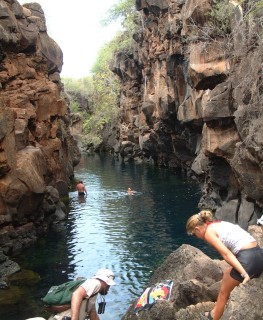 Tony and Amanda climb down into the clear waters of Las Grietas |
The two nicest things about Santa Cruz, however, were the arrival of my uncle Tony to see the Galapagos with us, and the chance to take a guided tour and see many of the nearby islands.
(Sue) We
spent about 2 weeks here in the main town of the Galapagos, and though it was a
bit touristy, it was still an interesting place to hang out. It is also the best
place from which to book a "last minute tour" on one of the Tour
Boats. Anyone wanting to save a few bucks on a tour can come stay in a
little pension for a few nights and then save a bundle on a Tour Boat.
There are lots of tour agencies, and the living is cheap while you wait.
I enjoyed the dinners out for $2 (yes, two dollars), the friendly people,
the the wonderful walks. We traipsed out to Tortuga Beach many times, both to
swim and animal watch. We also explored the coast line and took a chilly swim in
Las Grietas, a roofless lava-tube with clear water. The Darwin Center was worth
several visits, and we took the public bus ride to the northern end of the
island several times to and from the airport on Baltras Island.
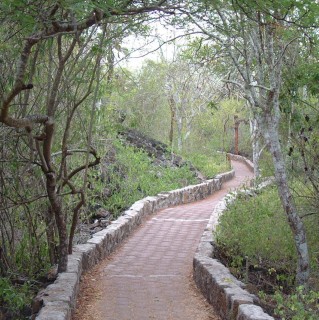 The delightful, long trail out to Tortuga Beach |
(Jon)
The anchorage in Santa Cruz is totally exposed to the south, and all the boats have
to use stern anchors to keep them pointed into the swell. These are not
ideal anchoring conditions and we probably wouldn't have stayed as long as we
did, but it's also where most of the tour boat offices are, where the major
airport is (so we could connect with my brother Tony), and it has a dentist who
could build a crown in-situ in about an hour! It also had enough friends
and places to play that the time flew by.
The crowns were interesting. The dentist would splab a little gloop on my
tooth, hit it with some ultraviolet light, and it would be hard. After 4-5
layers, he'd grind it down to fit, and then he'd send me home. No
anesthetic necessary. He did 2 of my teeth that way. Apparently,
enough scuba divers come to the Galapagos and have tooth troubles at pressure
that he keeps busy.
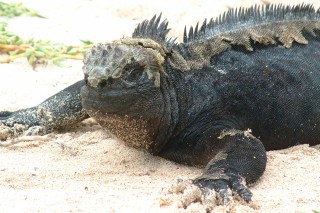 "I'm uglier than you are!" |
Santa Cruz was where we saw our first Marine Iguanas. These refugees from a Godzilla movie spend most of their time sleeping in a clump, all jumbled together, recharging their batteries in the sun and practicing looking gruesome. Then they dive in the water because their food is the algae that grows on the rocks underwater. They seem to be able to drink seawater, and when you surprise them sunning, they spit salt out their nostrils at you (very charming). They always seem to have a layer of dead skin on the top of their heads and along their dorsal spines, which adds considerably to their gruesomeness.
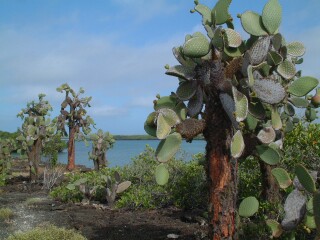 Opuntia trees on the Tortuga Beach nature trail |
The Darwin Center on Santa Cruz was interesting, with tortoises that they're raising to rebuild the original populations. They're very interested in preserving the genetic purity of the of the tortoises on different islands, as all are slightly different. (Apparently, there are some 13 separate species of Darwin's Finch). Some islands have been cleared of tortoises, so they're appealing to zoos around the world for those types. Lonesome George is apparently the last male of his species, and we got a bit of a sex-ed lesson as he tried to increase the population with one of his 2 lady friends. One interesting factoid is that the sex of the tortoise is determined by the incubation temperature of the egg. This allows the Darwin Center to produce more females, to rebuild the populations more quickly.
Ecuador Newsletters | Galapagos Newsletters | Galapagos Flora/Fauna
Top Level: Home | Destinations | Cruising Info | Underwater | Boat Guests | Ocelot | Sue | Jon | Amanda | Chris | Site Map | Make a Comment
|
If our information is useful, you can help by making a donation |
Copyright © 2000‑ Contact: Jon and Sue Hacking -- HackingFamily.com, svOcelot.com. All rights reserved.